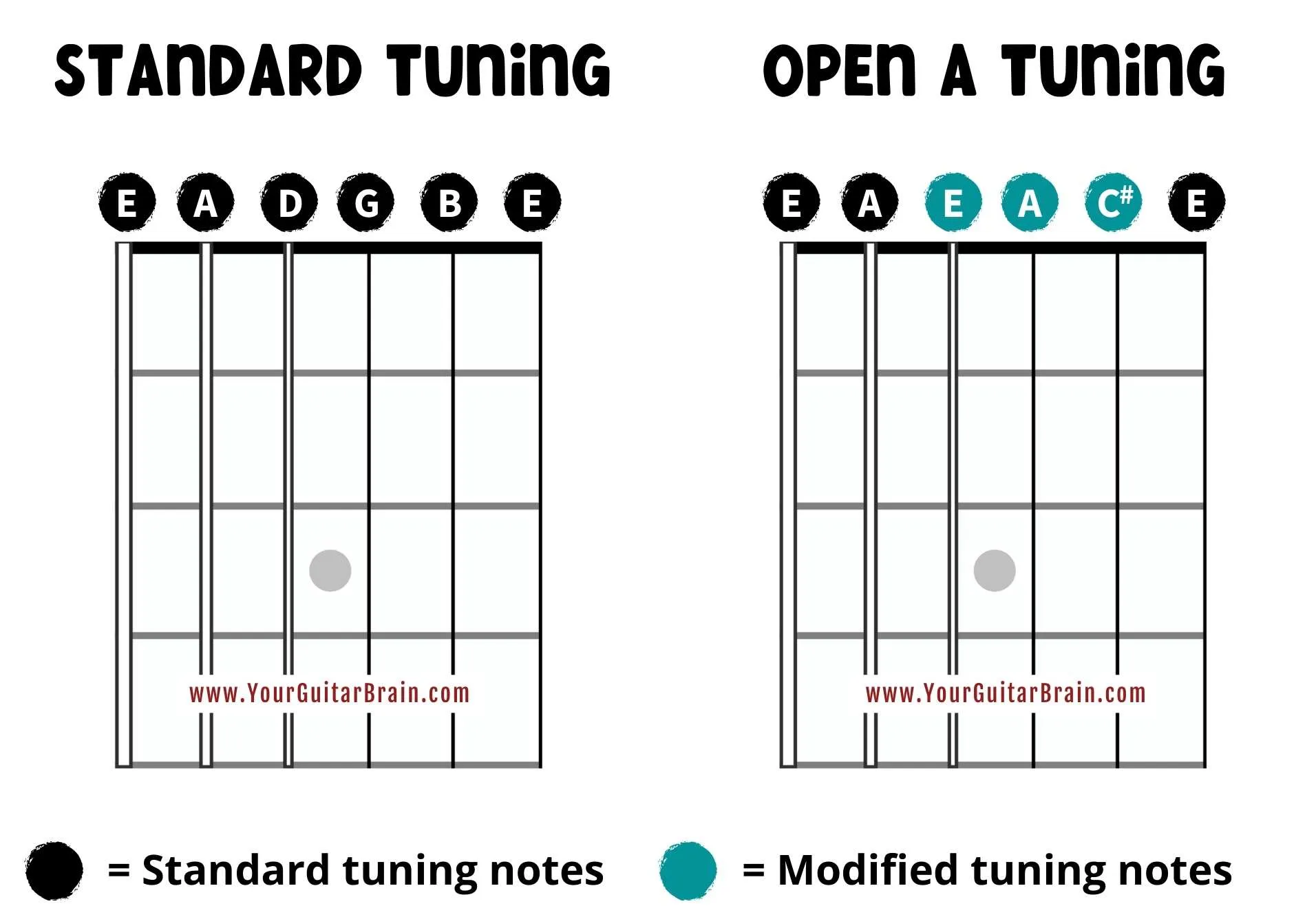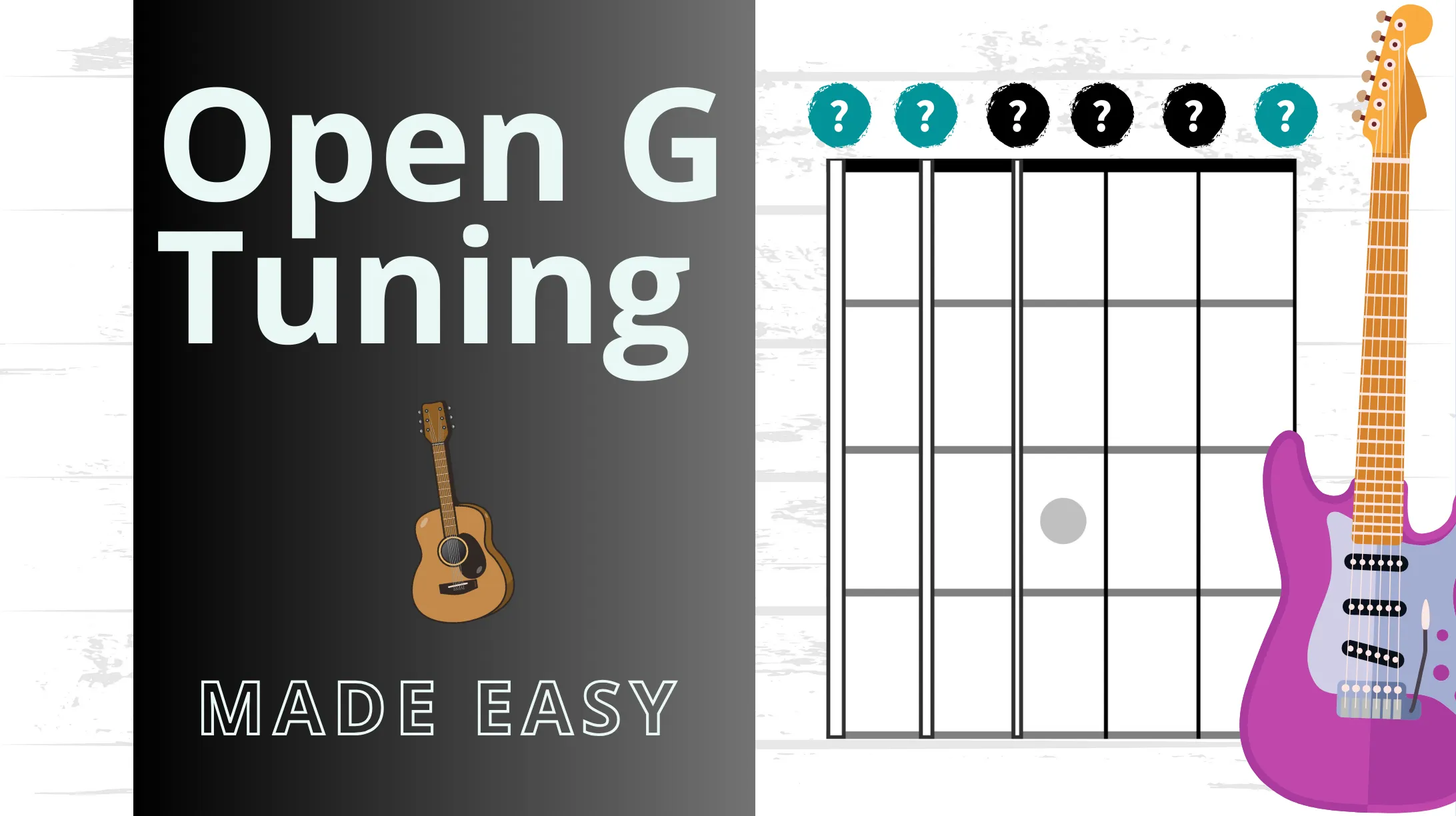Open A tuning notes, open A chord songs, easy A chord shapes, and how to tune your guitar to this slightly risky open tuning… 🎸
Open A tuning isn’t as common as open G tuning or open D tuning, but it’s a cool twist on standard tuning that Delta blues guitarists and bottleneck slide players love.
In this short post, we’ll learn all the essential basics of open A tuning you need to know.
Let’s slide on in!
What is Open A Tuning?
Open A tuning is a different way to tune your guitar strings so that when you strum without pressing any frets, they naturally produce a gorgeous airy-sounding A major chord.
To get open A tuning instead of standard guitar tuning (E-A-D-G-B-E), you adjust three strings to give you the new open A note tuning of E-A-E-A-C#-E.
The new string pitches match the root, third, and fifth intervals of an A major chord (A-C#-E).
If you’re after that deep, bluesy sound or want to make your guitar sing with less finger gymnastics, open A tuning is your friend.
Just remember to go easy on the strings; they’re not fans of too much tension, and guitar strings can snap if you’re too heavy-handed.
How Do You Tune Your Guitar to Open A Tuning?
As we just learned, tuning your guitar to open A involves changing the pitch of three strings to give you the new tuning of E-A-E-A-C#-E.
Here are the steps to help you easily tune your guitar to play in open A tuning:
- The low E and A strings stay the same as in standard tuning.
- Raise the D (4th) string by a tone (whole step) up to E.
- Raise the G (3rd) string up by a tone (whole step) to A.
- Raise the B (2nd) string up one whole step to C#.
- The top E (1st) string stays the same as in regular tuning.

Open A Tuning Notes Vs. Standard Tuning Notes
Pro Tip
Because you have to tune strings up in open A tuning, it does put a little more pressure on your strings, but here's a neat trick. If you already know open G tuning, you can slap a capo on the second fret to play in open A without re-tuning. Now you're a savvy strummer. 🙌
Open A Tuning Chords
Let’s now look at some easy major chord shapes to get you off the starting blocks with open A tuning.
What’s handy is that you can move this major triad shape up or down the neck to play any major chord you want; the root note will always be found on the fifth string.
Here’s tab showing you how to play an easy open A tuning major chord:👇

Open A Tuning Songs
Here are some classic songs in open A tuning that hover around the blues and blues-rock genres played by some of the best guitarists of all time:
- “Lonely Years” by Eric Clapton: A bluesy tune that’s great for practicing slide guitar in open A tuning.
- “Little Red Rooster” by Howlin’ Wolf: This gritty blues song by one of the best blues guitarists ever allows you to delve into classic blues riffs and slide techniques.
- “Bottle Up and Go” by John Lee Hooker: A foot-stomping blues number that embodies the essence of open A tuning, ideal for getting your teeth into this open tuning.
- “Down Child” by John Lee Hooker: Take a stroll through the Delta with this soulful track, letting the emotive sounds of open A tuning carry you away.
- “Leave My Wife Alone” by John Lee Hooker: Here’s your chance to tell a bluesy tale through your guitar, with open A tuning as your trusty storytelling buddy.
- “In My Time of Dying” by Led Zeppelin: A rock interpretation of a traditional gospel song, this Led Zep track is ideal for learning slide guitar in open A tuning.
- “I Can’t Be Satisfied” by Muddy Waters: Perfect for practicing fingerpicking and slide guitar in open A tuning, it’s time to get down and Muddy.
Summing it Up
Open A tuning might not be the first name that comes to mind when you think of guitar tunings, but as we’ve discovered, it holds a special place in the hearts of Delta blues guitarists and blues rockers all over the place.
It’s their go-to tuning for its ability to capture the soulful and raw emotion of the blues.
While open A tuning may not be as widely used in folk or mainstream music, its distinctive sound is what makes it stand out for rootsy blues guitarists.
Open A tuning reminds us that, sometimes, the less-traveled path can lead to the most profound musical experiences.
Have fun, superstars! 🎸










